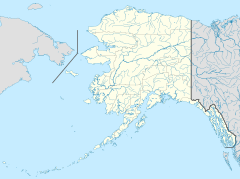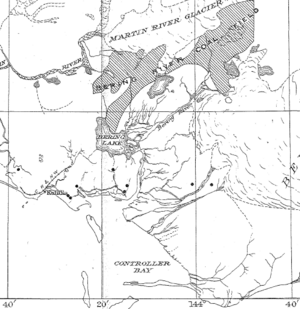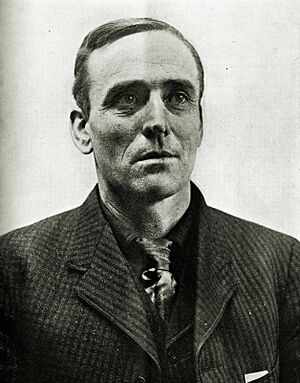Katalla, Alaska facts for kids
Quick facts for kids
Katalla
|
|
|---|---|

The steamers Altona and Thlinket unloading rail supplies in Katalla, 1907.
|
|
| Country | United States |
| State | Alaska |
| Census area | Valdez-Cordova |
| Time zone | UTC-9 (Alaska (AKST)) |
| • Summer (DST) | UTC-8 (AKDT) |
Katalla (say KA-tell-ah) is a ghost town located in Alaska, a state in the United States. It's about 76 kilometers (47 miles) southeast of a town called Cordova. Katalla was once a busy place, but now it's completely abandoned. Sometimes, its name was spelled Catalla.
Contents
Where is Katalla Located?
Katalla is found inside the Chugach National Forest. It is close to Controller Bay and the Bering River.
The Story of Katalla
Katalla became important because it was at the center of an oil field. This was where oil was first found in large amounts in Alaska, back in 1902. The town grew very quickly. By 1907-1908, about 5,000 people lived there.
Why Katalla Grew
The town grew because a railroad company, the Copper River and Northwestern Railway (CR&NW), planned to use Katalla as its main port. This port would connect the railroad to the Pacific Ocean and the rich coal fields of the Bering River.
Storms and Changes
However, big storms hit Katalla in the fall of 1907. These storms destroyed the new dock that was being built. Because of this damage, the railroad decided to move its main port to a nearby town called Cordova instead.
The SS Portland Shipwreck
In November 1910, during one of these strong autumn storms, a famous ship called the SS Portland ran aground and sank near Katalla. This ship was known as the "ship of gold."
The End of Katalla
Even after the railroad left, people in Katalla still relied on the small oil field for their jobs. But on December 25, 1933, a fire badly damaged the oil refinery. After the fire, the oil operations stopped completely. The town's post office closed in 1943, and soon after, the town was completely abandoned.
Who Owned the Oil Rights?
The rights to extract oil and gas in the Katalla area were given to the Chugach Alaska Corporation. This happened because of a law called the Alaska Native Claims Settlement Act. Before that, some of the rights were owned by other companies.
Interest in Coal
In the early 1980s, a group from Korea became interested in the coal fields near Katalla. They explored the Bering River coal fields. However, they found that getting the coal out would be too expensive. Also, any road to Katalla would have to cross areas that were unstable or affected by melting glaciers. So, their interest faded.
How Many People Lived There?
| Historical population | |||
|---|---|---|---|
| Census | Pop. | %± | |
| 1910 | 188 | — | |
| 1920 | 84 | −55.3% | |
| 1930 | 44 | −47.6% | |
| 1940 | 23 | −47.7% | |
| U.S. Decennial Census | |||
Katalla first appeared in the U.S. Census in 1910 as a small village. It was counted in the census until 1940. After that, the town was abandoned and no longer had people living there.




